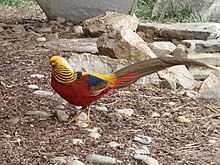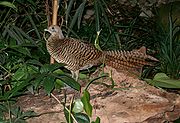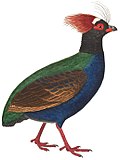Chrysolophus
| Chrysolophus | |
|---|---|

| |
| Male golden pheasant | |
| Scientific classification | |
| Domain: | Eukaryota |
| Kingdom: | Animalia |
| Phylum: | Chordata |
| Class: | Aves |
| Order: | Galliformes |
| Family: | Phasianidae |
| Tribe: | Phasianini |
| Genus: | Chrysolophus J.E. Gray, 1834 |
| Type species | |
| Phasianus pictus Linnaeus, 1758
| |
| Species | |
| |
Chrysolophus is a genus of the pheasant family of birds. The genus name is from Ancient Greek khrusolophos, "with golden crest".
These are species which have spectacularly plumaged males. The golden pheasant is native to western China, and Lady Amherst's pheasant to Tibet and westernmost China, but both have been widely introduced elsewhere. In places where self-supporting feral populations have become established, such as England, the two species will interbreed to produce hybrids.
Despite the male's showy appearance, these birds are very difficult to see in their natural habitat, which is dense, dark, young conifer forests with sparse undergrowth. Consequently, little is known of their behaviour in the wild.
They feed on the ground on grain, leaves and invertebrates, but roost in trees at night. Whilst they can fly, they prefer to run: but if startled they can suddenly burst upwards at great speed, with a distinctive wing sound.
Taxonomy
[edit]The genus Chrysolophus was introduced in a figure caption by the English zoologist John Edward Gray in 1834 for a single species, the golden pheasant (Phasianus pictus Linnaeus, 1758) which is therefore considered as the type species.[1][2] The genus name is from Ancient Greek χρυσολοφος/khrusolophos mening with "golden crest", from χρυσος/khrusos meaning "gold" and λοφος/lophos meaning "crest".[3] The genus now contains two species.[4]
Species
[edit]| Common name | Scientific name and subspecies | Range | Size and ecology | IUCN status and estimated population |
|---|---|---|---|---|
| Golden pheasant | Chrysolophus pictus (Linnaeus, 1758) |
Western China, introduced to Canada, the United States, Britain and elsewhere | Size: Habitat: Diet: |
LC
|
| Lady Amherst's pheasant | Chrysolophus amherstiae (Leadbeater, 1829) |
Tibet and western China
|
Size: Habitat: Diet: |
LC
|
References
[edit]- ^ Gray, John Edward (1834). Illustrations of Indian zoology chiefly selected from the collection of Major-General Harwdwicke, F.R.S. Vol. 2. London: Treuttel, Wurtz, Treuttel, Jun. and Richter. Plate 41, Fig. 2, Parts 15,16. Issued in parts. For the publication dates see: Wheeler, Alwyne (1998). "Dates of publication of J. E. Gray's Illustrations of Indian Zoology (1830-1835)". Archives of Natural History. 25 (3): 345–354.
- ^ Peters, James Lee, ed. (1934). Check-List of Birds of the World. Vol. 2. Cambridge, Massachusetts: Harvard University Press. p. 130.
- ^ Jobling, James A. "Chrysolophus". The Key to Scientific Names. Cornell Lab of Ornithology. Retrieved 15 February 2025.
- ^ Gill, Frank; Donsker, David; Rasmussen, Pamela, eds. (August 2024). "Pheasants, partridges, francolins". IOC World Bird List Version 14.2. International Ornithologists' Union. Retrieved 15 February 2025.








